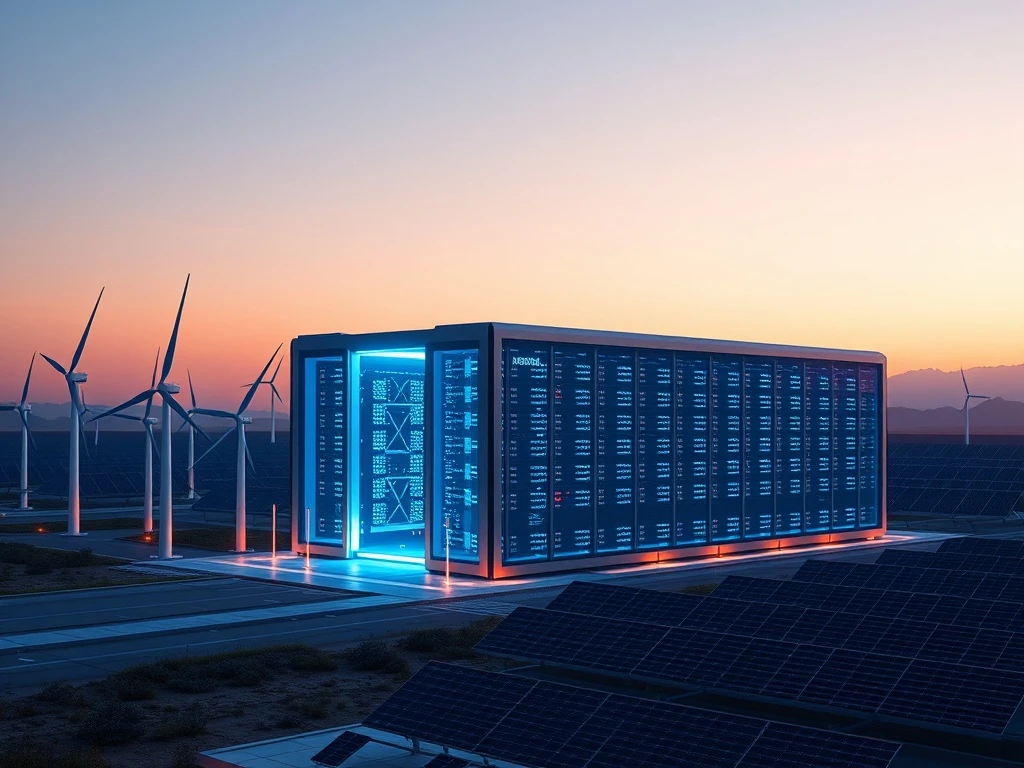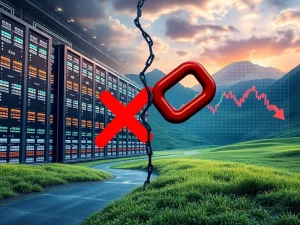Bitcoin Mining’s Transformative Leap: Bitzero Secures $25M for Sustainable HPC Expansion

The cryptocurrency world is constantly evolving, and today’s news highlights a significant stride towards a more sustainable and diversified future. Vancouver-based Bitzero, a prominent player in the digital asset space, has announced a substantial $25 million funding round. This capital infusion isn’t just about scaling operations; it’s a strategic move that underscores a broader industry shift, particularly in the realm of Bitcoin mining and high-performance computing (HPC). For anyone tracking the pulse of crypto innovation, this development signals a fascinating blend of growth, technological advancement, and environmental responsibility.
What’s Driving Bitzero’s Bold Bitcoin Mining Expansion?
Bitzero’s recent funding is earmarked to accelerate the deployment of 2,900 Bitmain S21 Pro miners over the next four to six months. This expansion is projected to generate an additional $10 million in revenue, a clear indicator of the company’s commitment to strengthening its core Bitcoin mining capabilities. However, this isn’t just about more miners; it’s about smart growth in a dynamic market.
- Strategic Deployment: The choice of Bitmain S21 Pro miners suggests a focus on efficiency and power, crucial for profitability in a post-halving environment.
- Revenue Projections: The anticipated $10 million in additional revenue highlights the immediate financial impact of this expansion, reinforcing Bitzero’s market position.
- Industry Adaptation: This move demonstrates Bitzero’s ability to adapt and scale its mining infrastructure while navigating the complexities of the crypto market.
Why is High-Performance Computing (HPC) the Next Frontier for Crypto Miners?
Beyond traditional Bitcoin mining, Bitzero’s strategic pivot towards High-Performance Computing (HPC) services is a key takeaway from this funding round. This sector is rapidly gaining traction as companies seek diversified, higher-margin revenue streams amidst the inherent volatility of crypto markets. The shift reflects a growing recognition that the immense computational power used for mining can be leveraged for other demanding tasks.
Companies like Bitfarms and Hive Digital Technologies are also making similar transitions, leveraging their energy assets and infrastructure for AI and data processing demands. Hive Digital, for example, reported an HPC revenue stream of $20 million annually in 2025, with forecasts indicating potential growth to $100 million by 2026. This illustrates the significant potential and increasing importance of HPC in the evolving digital landscape.
The synergy between crypto mining infrastructure and HPC is clear:
| Aspect | Bitcoin Mining | High-Performance Computing (HPC) |
|---|---|---|
| Primary Goal | Secure blockchain, earn rewards | Solve complex computational problems |
| Hardware Overlap | ASICs (Application-Specific Integrated Circuits) | GPUs (Graphics Processing Units) – increasingly specialized |
| Revenue Model | Block rewards, transaction fees | Service fees for computational power |
| Market Volatility Impact | High | Lower (more stable demand from diverse industries) |
How is Renewable Energy Powering Bitzero’s Green Vision?
Environmental sustainability is not just a buzzword for Bitzero; it’s a core operational principle. Since 2022, the company has prioritized zero-carbon mining, a commitment that aligns with increasing investor and regulatory expectations for green practices. Their partnership in Norway, which enables the utilization of renewable energy for mining operations, is a testament to this dedication.
This initiative positions Bitzero as a leader in integrating sustainability with technological innovation. The industry-wide shift toward sustainable mining reflects growing scrutiny of energy consumption in Bitcoin operations. Firms are increasingly adopting renewable energy sources to mitigate environmental impact and ensure long-term viability in a sector often criticized for its carbon footprint. Bitzero’s proactive approach with renewable energy sets a high standard for others to follow.
Why is Crypto Diversification Essential for Miners in a Volatile Market?
Market pressures, including declining Bitcoin block rewards post-halving, rising electricity costs, and maintenance expenses, have intensified the need for operational crypto diversification. Fidelity Digital Assets has highlighted that miners’ profitability now hinges on their ability to withstand market volatility and adopt emerging technologies. The traditional model of solely relying on block rewards is becoming less sustainable for many.
Bitzero’s strategy of combining HPC expansion with its core mining operations is a prime example of effective crypto diversification. By broadening their revenue streams, companies can mitigate risks associated with price fluctuations and regulatory changes, ensuring greater resilience and stability. This diversification strategy is crucial for long-term survival and growth in a competitive landscape.
What Does Bitzero’s Strategy Mean for the Future of Bitcoin Mining?
Bitzero‘s comprehensive strategy of retaining mined Bitcoin through a “Hodl” approach has also gained traction, especially as the asset’s price reached record highs of $123,000 in 2025. By combining HPC expansion, sustainable practices, and asset retention, the company aims to balance short-term resilience with long-term growth. This multi-pronged approach demonstrates a mature understanding of the crypto market’s complexities.
The broader crypto mining sector is actively redefining itself through such strategic pivots and sustainability commitments. Competitors like Bitfarms have rebranded to emphasize AI and HPC, leveraging energy assets in regions like Pennsylvania. These developments signal a maturing market where innovation and environmental responsibility are becoming key differentiators. Investors are increasingly prioritizing firms that demonstrate adaptability and sustainability, making companies like Bitzero attractive prospects.
In conclusion, Bitzero’s $25 million investment is more than just a financial milestone; it’s a blueprint for the future of crypto mining. By embracing high-performance computing, committing to renewable energy, and strategically diversifying its operations, Bitzero is not only securing its own growth but also contributing to a more sustainable and robust cryptocurrency ecosystem. This forward-thinking approach sets a precedent for the industry, emphasizing that innovation and environmental stewardship can indeed go hand in hand.
Frequently Asked Questions (FAQs)
Q1: What is High-Performance Computing (HPC) and why are Bitcoin miners moving into it?
A1: High-Performance Computing (HPC) involves using supercomputers and parallel processing techniques to solve complex computational problems. Bitcoin miners are moving into HPC because their existing infrastructure, particularly the powerful GPUs and ASICs used for mining, can be repurposed or dual-purposed for HPC tasks like AI training, scientific simulations, and data analytics. This provides diversified, higher-margin revenue streams, reducing reliance solely on volatile crypto mining rewards.
Q2: How does Bitzero ensure its Bitcoin mining operations are sustainable?
A2: Bitzero prioritizes zero-carbon mining and has been committed to it since 2022. They achieve this through a strategic partnership in Norway, which allows them to utilize renewable energy sources for their mining operations. This commitment significantly reduces their carbon footprint and aligns with growing investor and regulatory demands for environmentally responsible practices in the crypto industry.
Q3: What does the term “Hodl” mean in the context of Bitzero’s strategy?
A3: “Hodl” is a common term in the crypto community, originating from a misspelling of “hold,” which means to hold onto cryptocurrency rather than selling it. In Bitzero’s strategy, it refers to their approach of retaining the Bitcoin they mine, rather than immediately selling it. This allows them to benefit from potential future price appreciation of Bitcoin, balancing short-term operational needs with long-term asset growth.
Q4: How has the Bitcoin halving impacted mining companies like Bitzero?
A4: The Bitcoin halving event reduces the block reward for miners by half, directly impacting their revenue from new Bitcoin. This intensifies market pressures, making profitability more challenging. In response, companies like Bitzero are forced to become more efficient, reduce operational costs, and explore diversified revenue streams like HPC to maintain profitability and sustainability in a post-halving environment.
Q5: Are other crypto mining companies also diversifying into HPC?
A5: Yes, the trend of crypto mining companies diversifying into HPC is growing. The article mentions Bitfarms and Hive Digital Technologies as examples. These companies are leveraging their existing energy infrastructure and computational power to tap into the high-demand sectors of AI and data processing, recognizing the need for resilience and varied income sources in the evolving crypto landscape.









